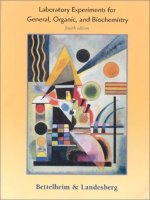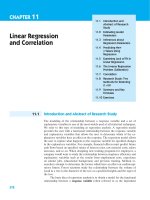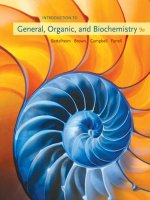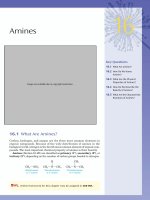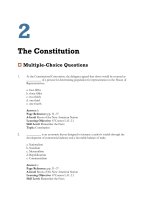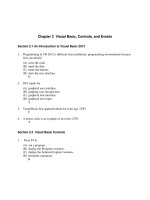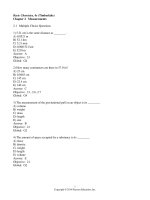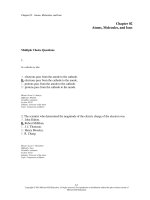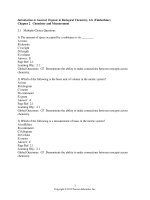Chemistry an introduction to general organic and biological chemistry 12th edition timberlake test bank
Bạn đang xem bản rút gọn của tài liệu. Xem và tải ngay bản đầy đủ của tài liệu tại đây (343.67 KB, 21 trang )
Introduction to General, Organic & Biological Chemistry, 12e (Timberlake)
Chapter 2 Chemistry and Measurement
2.1 Multiple-Choice Questions
1) The amount of space occupied by a substance is its ________.
A) mass
B) density
C) weight
D) length
E) volume
Answer: E
Page Ref: 2.1
Learning Obj.: 2.1
Global Outcomes: G7 Demonstrate the ability to make connections between concepts across
chemistry.
2) Which of the following is the basic unit of volume in the metric system?
A) liter
B) kilogram
C) meter
D) centimeter
E) gram
Answer: A
Page Ref: 2.1
Learning Obj.: 2.1
Global Outcomes: G7 Demonstrate the ability to make connections between concepts across
chemistry.
3) Which of the following is a measurement of mass in the metric system?
A) milliliter
B) centimeter
C) kilogram
D) Celsius
E) meter
Answer: C
Page Ref: 2.1
Learning Obj.: 2.1
Global Outcomes: G7 Demonstrate the ability to make connections between concepts across
chemistry.
1
Copyright © 2015 Pearson Education, Inc.
4) A value of 25 °C is a measurement of ________.
A) length
B) volume
C) temperature
D) mass
E) density
Answer: C
Page Ref: 2.1
Learning Obj.: 2.1
Global Outcomes: G7 Demonstrate the ability to make connections between concepts across
chemistry.
5) A value of 36 mL is a measure of ________.
A) density
B) mass
C) temperature
D) volume
E) length
Answer: D
Page Ref: 2.1
Learning Obj.: 2.1
Global Outcomes: G7 Demonstrate the ability to make connections between concepts across
chemistry.
6) A value of 345 mm is a measure of ________.
A) density
B) mass
C) temperature
D) volume
E) length
Answer: E
Page Ref: 2.1
Learning Obj.: 2.1
Global Outcomes: G7 Demonstrate the ability to make connections between concepts across
chemistry.
7) The measurement of the gravitational pull on an object is its ________.
A) volume
B) weight
C) mass
D) length
E) size
Answer: B
Page Ref: 2.1
Learning Obj.: 2.1
Global Outcomes: G7 Demonstrate the ability to make connections between concepts across
chemistry.
2
Copyright © 2015 Pearson Education, Inc.
8) Which of the following measurements has three significant figures?
A) 0.005 m
B) 510 m
C) 0.510 m
D) 0.051 m
E) 5100 m
Answer: C
Page Ref: 2.2
Learning Obj.: 2.2
Global Outcomes: G4 Demonstrate the quantitative skills needed to succeed in chemistry.
9) Which of the following numbers contains the designated correct number of significant
figures?
A) 0.04300 5 significant figures
B) 0.00302
2 significant figures
C) 156 000
3 significant figures
D) 1.04
2 significant figures
E) 3.0650
4 significant figures
Answer: C
Page Ref: 2.2
Learning Obj.: 2.2
Global Outcomes: G4 Demonstrate the quantitative skills needed to succeed in chemistry.
10) The number of significant figures in the measurement of 45.030 mm is ________.
A) none
B) three
C) four
D) five
E) six
Answer: D
Page Ref: 2.2
Learning Obj.: 2.2
Global Outcomes: G4 Demonstrate the quantitative skills needed to succeed in chemistry.
11) How many significant figures are in the number 0.00208?
A) six
B) two
C) three
D) four
E) five
Answer: C
Page Ref: 2.2
Learning Obj.: 2.2
Global Outcomes: G4 Demonstrate the quantitative skills needed to succeed in chemistry.
3
Copyright © 2015 Pearson Education, Inc.
12) Which of the following examples illustrates a number that is correctly rounded to three
significant figures?
A) 4.05438 g to 4.054 g
B) 0.03954 g to 0.040 g
C) 103.692 g to 103.7 g
D) 109 526 g to 109 500 g
E) 20.0332 g to 20.0 g
Answer: E
Page Ref: 2.3
Learning Obj.: 2.3
Global Outcomes: G4 Demonstrate the quantitative skills needed to succeed in chemistry.
13) A calculator answer of 423.6059 must be rounded off to three significant figures. What
answer is reported?
A) 423
B) 424
C) 1.7420
D) 423.6
E) 423.7
Answer: B
Page Ref: 2.3
Learning Obj.: 2.3
Global Outcomes: G4 Demonstrate the quantitative skills needed to succeed in chemistry.
14) Which of the answers for the following conversions contains the correct number of
significant figures?
A) 2.543 m ×
B) 2 L ×
= 100.1942 in.
= 2.12 qt
C) 24.95 min ×
D) 12.0 ft ×
E) 24.0 kg ×
= 0.4158 hr
×
= 370 cm
= 11 lb
Answer: C
Page Ref: 2.3
Learning Obj.: 2.3
Global Outcomes: G4 Demonstrate the quantitative skills needed to succeed in chemistry.
4
Copyright © 2015 Pearson Education, Inc.
15) What is the correct answer for the calculation of a volume (in mL) with measured numbers
?
A) 0.22 mL
B) 0.223 mL
C) 57 mL
D) 14 mL
E) 14.3 mL
Answer: A
Page Ref: 2.3
Learning Obj.: 2.3
Global Outcomes: G4 Demonstrate the quantitative skills needed to succeed in chemistry.
16) When 2610 + 11.7 + 0.22 are added, the answer to the correct number of decimal places is
________.
A) 2621.92
B) 2621.9
C) 2621
D) 2620
E) 2600
Answer: D
Page Ref: 2.3
Learning Obj.: 2.3
Global Outcomes: G4 Demonstrate the quantitative skills needed to succeed in chemistry.
17) What is the answer, with the correct number of decimal places, for this problem?
4.392 g + 102.40 g + 2.51 g =
A) 109.302 g
B) 109 g
C) 109.3 g
D) 109.30 g
E) 110 g
Answer: D
Page Ref: 2.3
Learning Obj.: 2.3
Global Outcomes: G4 Demonstrate the quantitative skills needed to succeed in chemistry.
5
Copyright © 2015 Pearson Education, Inc.
18) The correct answer for the addition of 7.5 g + 2.26 g + 1.311 g + 2 g is ________.
A) 13.071 g
B) 13 g
C) 13.0 g
D) 10 g
E) 13.1 g
Answer: B
Page Ref: 2.3
Learning Obj.: 2.3
Global Outcomes: G4 Demonstrate the quantitative skills needed to succeed in chemistry.
19) In which of the following is the metric unit paired with its correct abbreviation?
A) microgram / mg
B) milliliter / mL
C) centimeter / km
D) kilogram / cg
E) gram / gm
Answer: B
Page Ref: 2.4
Learning Obj.: 2.4
Global Outcomes: G7 Demonstrate the ability to make connections between concepts across
chemistry.
20) Which of the following is the largest unit?
A) millimeter
B) micrometer
C) meter
D) decimeter
E) kilometer
Answer: E
Page Ref: 2.4
Learning Obj.: 2.4
Global Outcomes: G7 Demonstrate the ability to make connections between concepts across
chemistry.
21) What is the metric relationship between grams and micrograms?
A) 1 g = 100 μg
B) 1 g = 1 000 000 μg
C) 1 g = 0.000 001 μg
D) 1 g = 1000 μg
E) 1 g = 0.001 μg
Answer: B
Page Ref: 2.4
Learning Obj.: 2.4
Global Outcomes: G4 Demonstrate the quantitative skills needed to succeed in chemistry.
6
Copyright © 2015 Pearson Education, Inc.
22) Which of the following is the smallest unit?
A) gram
B) milligram
C) kilogram
D) decigram
E) microgram
Answer: E
Page Ref: 2.4
Learning Obj.: 2.4
Global Outcomes: G7 Demonstrate the ability to make connections between concepts across
chemistry.
23) The cubic centimeter (c or cc) has the same volume as a ________.
A) cubic inch
B) cubic liter
C) milliliter
D) centimeter
E) cubic decimeter
Answer: C
Page Ref: 2.4
Learning Obj.: 2.4
Global Outcomes: G7 Demonstrate the ability to make connections between concepts across
chemistry.
24) What is the conversion factor for the relationship between millimeters and centimeters?
A) 1 mm/1 cm
B) 10 mm/1 cm
C) 1 cm/1 mm
D) 100 mm/1 cm
E) 10 cm/1 mm
Answer: B
Page Ref: 2.5
Learning Obj.: 2.5
Global Outcomes: G4 Demonstrate the quantitative skills needed to succeed in chemistry.
25) Which of the following conversion factors is a measured number?
A) 10 cm/dm
B) 12 in/ft
C) 16 oz/lb
D) 25 miles/gallon
E) 12 eggs/dozen
Answer: D
Page Ref: 2.5
Learning Obj.: 2.5
Global Outcomes: G4 Demonstrate the quantitative skills needed to succeed in chemistry.
7
Copyright © 2015 Pearson Education, Inc.
26) A conversion factor set up correctly to convert 15 inches to centimeters is ________.
A) 100 cm/1 m
B) 1 inch/2.54 cm
C) 1 cm/10 mm
D) 2.54 cm/1 inch
E) 10 cm/1 inch
Answer: D
Page Ref: 2.5
Learning Obj.: 2.5
Global Outcomes: G4 Demonstrate the quantitative skills needed to succeed in chemistry.
27) 9.31 g is the same mass as ________.
A) 931 μg
B) 931 kg
C) 93.1 cg
D) 9310 mg
E) 0.0931 dg
Answer: D
Page Ref: 2.6
Learning Obj.: 2.6
Global Outcomes: G4 Demonstrate the quantitative skills needed to succeed in chemistry.
28) According to the United States Food and Drug Administration, the recommended daily
requirement of protein is 44 g. This is ________ of protein.
A) 1248.5 oz
B) 320 000 oz
C) 1.6 oz
D) 0.0605 oz
E) 150 000 oz
Answer: C
Page Ref: 2.6
Learning Obj.: 2.6
Global Outcomes: G4 Demonstrate the quantitative skills needed to succeed in chemistry.
29) 1.00 pint of milk has a volume of how many milliliters?
A) 473 mL
B) 530. mL
C) 1000 mL
D) 1890 mL
E) 106 mL
Answer: A
Page Ref: 2.6
Learning Obj.: 2.6
Global Outcomes: G4 Demonstrate the quantitative skills needed to succeed in chemistry.
8
Copyright © 2015 Pearson Education, Inc.
30) Which of the following setups would convert centimeters to feet?
A) cm ×
×
B) cm ×
×
C) cm ×
×
D) cm ×
×
E) cm ×
×
Answer: C
Page Ref: 2.6
Learning Obj.: 2.6
Global Outcomes: G4 Demonstrate the quantitative skills needed to succeed in chemistry.
31) How many pounds are in 3.5 kg?
A) 7.7 lb
B) 1.59 lb
C) 0.629 lb
D) 1.6 lb
E) 7.70 lb
Answer: A
Page Ref: 2.6
Learning Obj.: 2.6
Global Outcomes: G4 Demonstrate the quantitative skills needed to succeed in chemistry.
32) How many liters of soft drink are there in 5.25 qt?
A) 4950 L
B) 55.7 L
C) 4.95 L
D) 5.57 L
E) 5.0 L
Answer: C
Page Ref: 2.6
Learning Obj.: 2.6
Global Outcomes: G4 Demonstrate the quantitative skills needed to succeed in chemistry.
9
Copyright © 2015 Pearson Education, Inc.
33) 5.21 cm is the same length as ________.
A) 0.0521 m
B) 52.1 dm
C) 5.21 mm
D) 0.00521 km
E) 5210 m
Answer: A
Page Ref: 2.6
Learning Obj.: 2.6
Global Outcomes: G4 Demonstrate the quantitative skills needed to succeed in chemistry.
34) How many centimeters are there in 57.0 in.?
A) 22 cm
B) 0.0445 cm
C) 145 cm
D) 22.4 cm
E) 140 cm
Answer: C
Page Ref: 2.6
Learning Obj.: 2.6
Global Outcomes: G4 Demonstrate the quantitative skills needed to succeed in chemistry.
35) What is 6.5 m converted to inches?
A) 1700 in
B) 1651 in
C) 39 in
D) 260 in
E) 255.9 in
Answer: D
Page Ref: 2.6
Learning Obj.: 2.6
Global Outcomes: G4 Demonstrate the quantitative skills needed to succeed in chemistry.
36) How many kilograms are in 30.4 lb?
A) 13.8 kg
B) 14 kg
C) 67 kg
D) 66.88 kg
E) 66.9 kg
Answer: A
Page Ref: 2.6
Learning Obj.: 2.6
Global Outcomes: G4 Demonstrate the quantitative skills needed to succeed in chemistry.
10
Copyright © 2015 Pearson Education, Inc.
37) A dose of aspirin of 5.0 mg per kilogram of body weight has been prescribed to reduce the
fever of an infant weighing 8.5 pounds. The number of milligrams of aspirin that should be
administered is ________.
A) 19 mg
B) 53 mg
C) 1.6 mg
D) 5.0 mg
E) 0.59 mg
Answer: A
Page Ref: 2.6
Learning Obj.: 2.6
Global Outcomes: G4 Demonstrate the quantitative skills needed to succeed in chemistry.
38) A doctor's order is 0.125 g of ampicillin. The liquid suspension on hand contains 250 mg/5.0
mL. How many milliliters of the suspension are required?
A) 0.0025 mL
B) 3.0 mL
C) 2.5 mL
D) 6.3 mL
E) 0.0063 mL
Answer: C
Page Ref: 2.6
Learning Obj.: 2.6
Global Outcomes: G4 Demonstrate the quantitative skills needed to succeed in chemistry.
39) Which of the following measurements are not equivalent?
A) 25 mg = 0.025 g
B) 183 L = 0.183 kL
C) 150 ms = 0.150 s
D) 84 cm = 8.4 mm
E) 24 dL = 2.4 L
Answer: D
Page Ref: 2.6
Learning Obj.: 2.6
Global Outcomes: G4 Demonstrate the quantitative skills needed to succeed in chemistry.
40) Which one of the following substances will float in gasoline, which has a density of 0.74
g/mL? The density of each substance is shown in parentheses.
A) table salt (D = 2.16 g/mL)
B) balsa wood (D = 0.16 g/mL)
C) sugar
(D = 1.59 g/mL)
D) aluminum (D = 2.70 g/mL)
E) mercury (D = 13.6 g/mL)
Answer: B
Page Ref: 2.7
Learning Obj.: 2.7
Global Outcomes: G4 Demonstrate the quantitative skills needed to succeed in chemistry.
11
Copyright © 2015 Pearson Education, Inc.
41) What is the mass of 2.00 L of an intravenous glucose solution with a density of 1.15 g/mL?
A) 0.0230 kg
B) 2.30 kg
C) 1.15 kg
D) 0.0150 kg
E) 0.575 kg
Answer: B
Page Ref: 2.7
Learning Obj.: 2.7
Global Outcomes: G4 Demonstrate the quantitative skills needed to succeed in chemistry.
42) Mercury has a specific gravity of 13.6. How many milliliters of mercury have a mass of 0.35
kg?
A) 0.0257 mL
B) 0.026 mL
C) 25.7 mL
D) 26 mL
E) 4760 mL
Answer: D
Page Ref: 2.7
Learning Obj.: 2.7
Global Outcomes: G4 Demonstrate the quantitative skills needed to succeed in chemistry.
43) What is the density of a substance with a mass of 45.00 g and a volume of 26.4 mL?
A) 1.70 g/mL
B) 1.7 g/mL
C) 0.59 g/mL
D) 0.587 g/mL
E) 45.0 g/mL
Answer: A
Page Ref: 2.7
Learning Obj.: 2.7
Global Outcomes: G4 Demonstrate the quantitative skills needed to succeed in chemistry.
44) What is the mass of 53 mL of ethanol, which has a density of 0.79 g/mL?
A) 67.1 g
B) 41.9 g
C) 42 g
D) 67 g
E) 53 g
Answer: C
Page Ref: 2.7
Learning Obj.: 2.7
Global Outcomes: G4 Demonstrate the quantitative skills needed to succeed in chemistry.
12
Copyright © 2015 Pearson Education, Inc.
45) A liquid has a volume of 34.6 mL and a mass of 46.0 g. What is the density of the liquid?
A) 1.00 g/mL
B) 1.33 g/mL
C) 0.752 g/mL
D) 1330 g/mL
E) 0.663 g/mL
Answer: B
Page Ref: 2.7
Learning Obj.: 2.7
Global Outcomes: G4 Demonstrate the quantitative skills needed to succeed in chemistry.
46) The density of a solution is 1.18 g/mL. Its specific gravity is ________.
A) 11.8
B) 0.118
C) 0.847
D) 1.18
E) 1.2
Answer: D
Page Ref: 2.7
Learning Obj.: 2.7
Global Outcomes: G4 Demonstrate the quantitative skills needed to succeed in chemistry.
47) Diamond has a density of 3.52 g/mL. What is the volume in cubic centimeters of a diamond
with a mass of 15.1 g?
A) 4.3
B) 4.29
C) 0.233
D) 53
E) 53.2
Answer: B
Page Ref: 2.7
Learning Obj.: 2.7
Global Outcomes: G4 Demonstrate the quantitative skills needed to succeed in chemistry.
48) The ratio of the mass of a substance to its volume is its ________.
A) specific gravity
B) density
C) buoyancy
D) weight
E) conversion factor
Answer: B
Page Ref: 2.7
Learning Obj.: 2.7
Global Outcomes: G7 Demonstrate the ability to make connections between concepts across
chemistry.
13
Copyright © 2015 Pearson Education, Inc.
49) A nugget of gold with a mass of 521 g is added to 50.0 mL of water. The water level rises to
a volume of 77.0 mL. What is the density of the gold?
A) 10.4 g/mL
B) 6.77 g/mL
C) 1.00 g/mL
D) 0.0518 g/mL
E) 19.3 g/mL
Answer: E
Page Ref: 2.7
Learning Obj.: 2.7
Global Outcomes: G4 Demonstrate the quantitative skills needed to succeed in chemistry.
50) A 50.0 mL urine sample has a mass of 50.7 g. The specific gravity of the urine is ________.
A) 1.014 g/mL
B) 0.986 g/L
C) 1.01
D) 0.986
E) 50.7
Answer: C
Page Ref: 2.7
Learning Obj.: 2.7
Global Outcomes: G4 Demonstrate the quantitative skills needed to succeed in chemistry.
2.2 Short Answer Questions
Round off each of the following to three significant figures.
1) 504.85
Answer: 505
Page Ref: 2.2
Learning Obj.: 2.2
Global Outcomes: G4 Demonstrate the quantitative skills needed to succeed in chemistry.
2) 8.3158
Answer: 8.32
Page Ref: 2.2
Learning Obj.: 2.2
Global Outcomes: G4 Demonstrate the quantitative skills needed to succeed in chemistry.
3) 25 225
Answer: 25 200
Page Ref: 2.2
Learning Obj.: 2.2
Global Outcomes: G4 Demonstrate the quantitative skills needed to succeed in chemistry.
14
Copyright © 2015 Pearson Education, Inc.
4) 6.3477 ×
Answer: 6.35 ×
Page Ref: 2.2
Learning Obj.: 2.2
Global Outcomes: G4 Demonstrate the quantitative skills needed to succeed in chemistry.
5) 399870
Answer: 4.00 ×
Page Ref: 2.2
Learning Obj.: 2.2
Global Outcomes: G4 Demonstrate the quantitative skills needed to succeed in chemistry.
6) 58.5422
Answer: 58.5
Page Ref: 2.2
Learning Obj.: 2.2
Global Outcomes: G4 Demonstrate the quantitative skills needed to succeed in chemistry.
7) 0.003 4088
Answer: 0.00341
Page Ref: 2.2
Learning Obj.: 2.2
Global Outcomes: G4 Demonstrate the quantitative skills needed to succeed in chemistry.
State the number of significant figures in each of the following measurements.
8) 0.705 m
Answer: 3
Page Ref: 2.2
Learning Obj.: 2.2
Global Outcomes: G4 Demonstrate the quantitative skills needed to succeed in chemistry.
9) 680 000 km
Answer: 2
Page Ref: 2.2
Learning Obj.: 2.2
Global Outcomes: G4 Demonstrate the quantitative skills needed to succeed in chemistry.
10) 0.008090 cm
Answer: 4
Page Ref: 2.2
Learning Obj.: 2.2
Global Outcomes: G4 Demonstrate the quantitative skills needed to succeed in chemistry.
15
Copyright © 2015 Pearson Education, Inc.
11) 28.050 km
Answer: 5
Page Ref: 2.2
Learning Obj.: 2.2
Global Outcomes: G4 Demonstrate the quantitative skills needed to succeed in chemistry.
12) 0.0005 L
Answer: 1
Page Ref: 2.2
Learning Obj.: 2.2
Global Outcomes: G4 Demonstrate the quantitative skills needed to succeed in chemistry.
13) 75.00 m
Answer: 4
Page Ref: 2.2
Learning Obj.: 2.2
Global Outcomes: G4 Demonstrate the quantitative skills needed to succeed in chemistry.
14) 2.043 ×
mm
Answer: 4
Page Ref: 2.2
Learning Obj.: 2.2
Global Outcomes: G4 Demonstrate the quantitative skills needed to succeed in chemistry.
15) 6.1 ×
mL
Answer: 2
Page Ref: 2.2
Learning Obj.: 2.2
Global Outcomes: G4 Demonstrate the quantitative skills needed to succeed in chemistry.
16) 9.00 ×
g
Answer: 3
Page Ref: 2.2
Learning Obj.: 2.2
Global Outcomes: G4 Demonstrate the quantitative skills needed to succeed in chemistry.
17) If there are 14 books on the shelf, 14 is a(n) ________ number.
Answer: exact
Page Ref: 2.2
Learning Obj.: 2.2
Global Outcomes: G4 Demonstrate the quantitative skills needed to succeed in chemistry.
16
Copyright © 2015 Pearson Education, Inc.
2.3 True/False Questions
1) The basic unit of mass in the metric system is the pound.
Answer: FALSE
Page Ref: 2.1
Learning Obj.: 2.1
Global Outcomes: G7 Demonstrate the ability to make connections between concepts across
chemistry.
2) The liter is a unit of volume in the metric system.
Answer: TRUE
Page Ref: 2.1
Learning Obj.: 2.1
Global Outcomes: G7 Demonstrate the ability to make connections between concepts across
chemistry.
3) The number 0.0500 has four significant figures.
Answer: FALSE
Page Ref: 2.2
Learning Obj.: 2.2
Global Outcomes: G4 Demonstrate the quantitative skills needed to succeed in chemistry.
4) The number 650 000 has two significant figures.
Answer: TRUE
Page Ref: 2.2
Learning Obj.: 2.2
Global Outcomes: G4 Demonstrate the quantitative skills needed to succeed in chemistry.
5) When the measured number 0.0090 is multiplied by the measured number 87.10, the answer
has two significant figures.
Answer: TRUE
Page Ref: 2.3
Learning Obj.: 2.3
Global Outcomes: G4 Demonstrate the quantitative skills needed to succeed in chemistry.
6) When the measured number 675 is added to the measured number 87.10, the answer should be
rounded to the ones place.
Answer: TRUE
Page Ref: 2.3
Learning Obj.: 2.3
Global Outcomes: G4 Demonstrate the quantitative skills needed to succeed in chemistry.
7) A μg is larger than a mg.
Answer: FALSE
Page Ref: 2.4
Learning Obj.: 2.4
Global Outcomes: G4 Demonstrate the quantitative skills needed to succeed in chemistry.
17
Copyright © 2015 Pearson Education, Inc.
8) There are 1000 μg in a mg.
Answer: TRUE
Page Ref: 2.4
Learning Obj.: 2.4
Global Outcomes: G4 Demonstrate the quantitative skills needed to succeed in chemistry.
9) A cubic centimeter is a unit of length.
Answer: FALSE
Page Ref: 2.4
Learning Obj.: 2.4
Global Outcomes: G7 Demonstrate the ability to make connections between concepts across
chemistry.
10) 1 kg equivalent to 1000 mg.
Answer: TRUE
Page Ref: 2.5
Learning Obj.: 2.5
Global Outcomes: G4 Demonstrate the quantitative skills needed to succeed in chemistry.
11) 1 mL is equivalent to 1000 L.
Answer: FALSE
Page Ref: 2.5
Learning Obj.: 2.5
Global Outcomes: G4 Demonstrate the quantitative skills needed to succeed in chemistry.
12) The density of water is 1 kg/mL.
Answer: FALSE
Page Ref: 2.7
Learning Obj.: 2.7
Global Outcomes: G4 Demonstrate the quantitative skills needed to succeed in chemistry.
13) Specific gravity has no units.
Answer: TRUE
Page Ref: 2.7
Learning Obj.: 2.7
Global Outcomes: G7 Demonstrate the ability to make connections between concepts across
chemistry.
18
Copyright © 2015 Pearson Education, Inc.
2.4 Matching Questions
Match the type of measurement to the unit given below.
A) mass
B) volume
C) temperature
D) length
E) density
1) milliliter
Page Ref: 2.1
Learning Obj.: 2.1
Global Outcomes: G7 Demonstrate the ability to make connections between concepts across
chemistry.
2) mm
Page Ref: 2.1
Learning Obj.: 2.1
Global Outcomes: G7 Demonstrate the ability to make connections between concepts across
chemistry.
3) gram
Page Ref: 2.1
Learning Obj.: 2.1
Global Outcomes: G7 Demonstrate the ability to make connections between concepts across
chemistry.
4) 125 K
Page Ref: 2.1
Learning Obj.: 2.1
Global Outcomes: G7 Demonstrate the ability to make connections between concepts across
chemistry.
5) kilometer
Page Ref: 2.1
Learning Obj.: 2.1
Global Outcomes: G7 Demonstrate the ability to make connections between concepts across
chemistry.
6) milligram
Page Ref: 2.1
Learning Obj.: 2.1
Global Outcomes: G7 Demonstrate the ability to make connections between concepts across
chemistry.
Answers: 1) B 2) D 3) A 4) C 5) D 6) A
19
Copyright © 2015 Pearson Education, Inc.
Are the numbers in each of the following statements measured or exact?
A) exact
B) measured
7) In the U.S. system there are 12 inches in one foot.
Page Ref: 2.2
Learning Obj.: 2.2
Global Outcomes: G4 Demonstrate the quantitative skills needed to succeed in chemistry.
8) The patient's blood sugar level is 350 mg/dL.
Page Ref: 2.2
Learning Obj.: 2.2
Global Outcomes: G4 Demonstrate the quantitative skills needed to succeed in chemistry.
9) There are 452 pages in a book.
Page Ref: 2.2
Learning Obj.: 2.2
Global Outcomes: G4 Demonstrate the quantitative skills needed to succeed in chemistry.
10) The rabbit weighs 2.5 pounds.
Page Ref: 2.2
Learning Obj.: 2.2
Global Outcomes: G4 Demonstrate the quantitative skills needed to succeed in chemistry.
11) 1L is equal to 1.06 quarts.
Page Ref: 2.2
Learning Obj.: 2.2
Global Outcomes: G4 Demonstrate the quantitative skills needed to succeed in chemistry.
12) There are 100 capsules in the bottle.
Page Ref: 2.2
Learning Obj.: 2.2
Global Outcomes: G4 Demonstrate the quantitative skills needed to succeed in chemistry.
13) The patient's temperature is 100.1 °F.
Page Ref: 2.2
Learning Obj.: 2.2
Global Outcomes: G4 Demonstrate the quantitative skills needed to succeed in chemistry.
14) I lost 14 pounds on my diet last month.
Page Ref: 2.2
Learning Obj.: 2.2
Global Outcomes: G4 Demonstrate the quantitative skills needed to succeed in chemistry.
Answers: 7) A 8) B 9) A 10) B 11) B 12) A 13) B 14) B
20
Copyright © 2015 Pearson Education, Inc.
Select the correct prefix to complete the equality.
A) 10
B) 1000
C) 1
D) 100
15) 1 mL = ________ L
Page Ref: 2.4
Learning Obj.: 2.4
Global Outcomes: G4 Demonstrate the quantitative skills needed to succeed in chemistry.
16) 1 m = ________ mm
E) 0.001
Page Ref: 2.4
Learning Obj.: 2.4
Global Outcomes: G4 Demonstrate the quantitative skills needed to succeed in chemistry.
17) 1 cm = ________ mm
Page Ref: 2.4
Learning Obj.: 2.4
Global Outcomes: G4 Demonstrate the quantitative skills needed to succeed in chemistry.
18) 1 dL = ________ mL
Page Ref: 2.4
Learning Obj.: 2.4
Global Outcomes: G4 Demonstrate the quantitative skills needed to succeed in chemistry.
19) 1 mL = ________ cm3
Page Ref: 2.4
Learning Obj.: 2.4
Global Outcomes: G4 Demonstrate the quantitative skills needed to succeed in chemistry.
20) 1 kg = ________ g
Page Ref: 2.4
Learning Obj.: 2.4
Global Outcomes: G4 Demonstrate the quantitative skills needed to succeed in chemistry.
Answers: 15) E 16) B 17) A 18) D 19) C 20) B
21
Copyright © 2015 Pearson Education, Inc.
